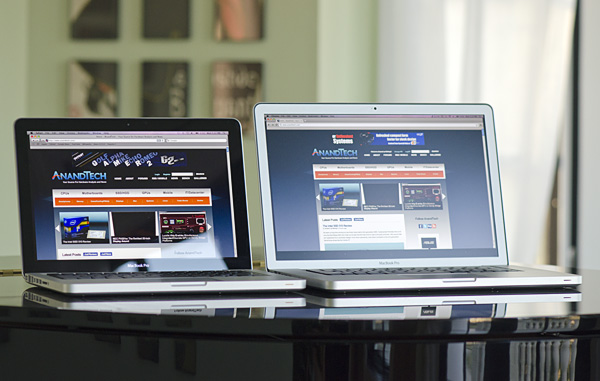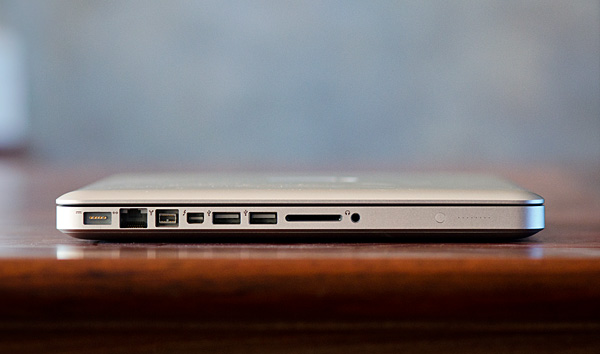The MacBook Pro Review (13 & 15-inch): 2011 Brings Sandy Bridge
by Anand Lal Shimpi, Brian Klug & Vivek Gowri on March 10, 2011 4:17 PM EST- Posted in
- Laptops
- Mac
- Apple
- Intel
- MacBook Pro
- Sandy Bridge
Final Words
For as little attention as the 2011 MacBook Pro launch was given by Apple, there sure is a lot to talk about.
The advantages are numerous. With the 13-inch MacBook Pro, under OS X at least, there simply aren't any downsides. You get much better CPU performance over the previous generation. In fact, the new 13 can outperform last year's 15 thanks to Sandy Bridge. The new 13 is quite possibly the best balance of portability and performance. It's the single largest upgrade you'll find in the lineup. If you own a previous generation 13-inch MBP, the upgrade is 100% worth it. Graphics performance is solid under OS X however questionable under Windows. For some reason we actually saw a step back in GPU performance vs. last year's 13-inch MBP when running games in Windows 7.
The 15-inch MacBook Pro is a beast. Although it comes in the same chassis as last year's model, it delivers much more performance. The move to quad-core Sandy Bridge makes the 15-inch MacBook Pro's performance formidable. Whereas I couldn't use the 2010 15 as my primary work machine, with an SSD the 2011 15-inch MBP does just fine.
Displays haven't really changed, which is both good and bad. On the one hand, Apple's MacBook Pros have always used good quality panels. On the other hand I'd like to see a higher res option for the 13-inch display—1280 x 800 is a big turnoff for me with the 13-inch model.
Thunderbolt is a nice addition however I expect that it'll be grossly underused for a while. We'll see some nice Thunderbolt enabled external storage solutions this Spring (helping perpetuate the mobile desktop usage model), but it'll be a while before we get the single-cable carrying USB, Ethernet, FireWire and DisplayPort to a display.
The WiFi improvements are welcome, although surprisingly absent from Apple's marketing collateral. The front facing 720p camera is also a nice touch.
It's not all rosy however. Apple fails to really take advantage of one of Sandy Bridge's biggest features: Quick Sync. The hardware encoder is used in FaceTime HD but you still get some very high CPU usage (at least of a single core). There's no support in QuickTime or iMovie 2011 for Quick Sync as of now, which is a major disappointment.
I mentioned that the 15-inch MacBook Pro is easily a desktop replacement, however you do have to deal with a loud fan under heavier CPU loads. Something a well designed desktop won't bother you with.
SSD support is still problematic. There are far too many reports of drives that don't work properly in the 2011 MacBook Pro, and Apple refuses to validate/ship anything but fairly mainstream SSD solutions. To make matters worse, although TRIM is finally enabled under OS X—it only works on Apple branded SSDs. I can understand Apple's desire to want to avoid dealing with the pitfalls of early SSDs with questionable firmware maturity, but I also believe it's Apple's duty to support as much hardware that's out there in the market today. If Apple offered something with SandForce SF-2200 class performance I'd have less of a bone to pick, but presently it doesn't.
Then there are the concerns about battery life. Under light usage there's a clear improvement over last year's models. The new 15-inch MacBook Pro is good for anywhere between 7—9 hours of light usage. That is assuming you don't have the dGPU running of course, at which point you should start talking about numbers below 5 hours. Even without the discrete GPU enabled, in the hands of a multitasker the new 15-inch MacBook Pro can easily burn through its 77Whr battery quicker than last year's model. While our worst case numbers don't look much lower than the 2010 model, the chances of you getting less than 2.5 hours out of the new 15 are much higher than they were last year.
The new 13-inch model is less of a concern when it comes to battery life. It's still got a 35W TDP dual-core CPU and no discrete GPU to sap power. It's the move to four cores and the additional GPU that really hurt the 15-inch MacBook Pro under heavy usage.
Overall the new lineup is a significant step forward. As I mentioned earlier, if you're in the market for a 13-inch system the 2011 Sandy Bridge MacBook Pro is likely the one to get. The 15 is just as easy to recommend, provided you're ok with the downsides (higher temperatures, louder fans, shorter battery life under load). If you aren't ok with the downsides, just wait another year and get the Ivy Bridge based successor.












198 Comments
View All Comments
zappb - Saturday, March 12, 2011 - link
Give me a mac book pro with windows 7 as a base install, and id be all over it.Mac OS sucks ass, don't know how anyone can make any money using it. Windows or ill stick to lenovo, would rather send my hard earned dollars to apple but as it stands, not a chance.
bymi - Saturday, March 12, 2011 - link
Hi,thanks for the great review of the new MacBooks!
I googled a lot, but was not able to find a working copy of the MSR Tools used in his article.
Sorry if this hat been discussed before, but i didn't find anything using the search funtionality here.
So where can i get these MSR Tools?
Thank you everybody for a link.
Best
bymi
Ryan Smith - Sunday, March 13, 2011 - link
http://www.insanelymac.com/forum/index.php?showtop...Note that it only works with Snow Leopard booted up in to 32bit mode, as the driver needed to read the MSRs is 32bit.
philipus - Saturday, March 12, 2011 - link
Does anyone know the approximate battery life when using Photoshop (I have CS5) with the dGPU enabled vs disabled?What is the approximate performance drop in Photoshop when not using the dGPU?
These are my main questions before deciding to get the 15" MBP.
Thanks for any insight.
/p
http://philipus.com
fcarnival - Sunday, March 13, 2011 - link
Hello Anandtech, thanks for the Apple's revenue breakdown. Could you also post the profit breakdown of Apple's products? I would like to know which device brings the most profit to Apple. Thanks!macfanpro - Monday, March 14, 2011 - link
I am very curious about this as well - with the tablet market supposedly tripling this year, I want to know what the ramifications are for earnings.Apple has a very nice page with related data (http://www.apple.com/investor/), but alas, I don't think they provide earnings breakdown by product (it's not in their detailed 70+ page annual report)...
amanrai - Monday, March 14, 2011 - link
could you confirm, definitively, whether or not the thunderbolt port will be able to support a discrete pci e based graphics card with or without a HDMI combination?thank you for all of your reviews. they are incredibly detailed and very helpful.
macfanpro - Monday, March 14, 2011 - link
Thanks so much for such an insightful review! I'm trying to rationalize buying a MBP, and I have two questions:Question about power draw) The MBP comes with a 85W adapter, but its maximum power draw is 93.2W. Could this lead to throttling/maximum performance not being achieved even when one is on the adapter?
Question about turbo boost) Some people have reported the turbo boost (for the i7 MBP 13) not working in Boot Camp. (Link: http://www.pcpro.co.uk/blogs/2011/03/10/apple-macb... Do you have any more news on this front?
anaboo - Monday, March 14, 2011 - link
Strong article - appreciate the in depth of benchmarks and insight.I'm hoping you guys can run the same set of in-depth Windows gaming benchmarks on the 15-inch MBP (particularly for the radeon gfx card). Curious to whether there is sub-optimal performance against a similar set of comparables (2010 MBPs, the Mac versions of these games, etc.).
Thanks!
davidglennbailey - Wednesday, March 16, 2011 - link
Best article on the internet on the new Macbook Pros. I'm ordering a 17" Macbook Pro on Friday. Here are my issues.1. Just take the cheap SATA hard drive now and upgrade to a fast SSD in the future when the prices fall a little farther? I will probably void a warranty? How difficult is the process to change one of those out and my chances of screwing something up? How do they even connect inside the machine and how reliable is it?
2. I can understand increased functionality spread out over the life of a product, but even at 3+ years is the .1ghz for 250$ ever worth it? Maybe for the increased cache or any other features?
3. Upgrading the memory was a breeze last time and shouldn't be an issue. Would there be any point or would it be even possible to go above 1333mhz or 8 gigs?
Just to add my 2 cents into the debate. I've had this Macbook Pro for about 5 years. I've put it through hell and back. Sometimes, you just wind up getting what you pay for. Great time to buy if you've been waiting for the quad cores for a while.